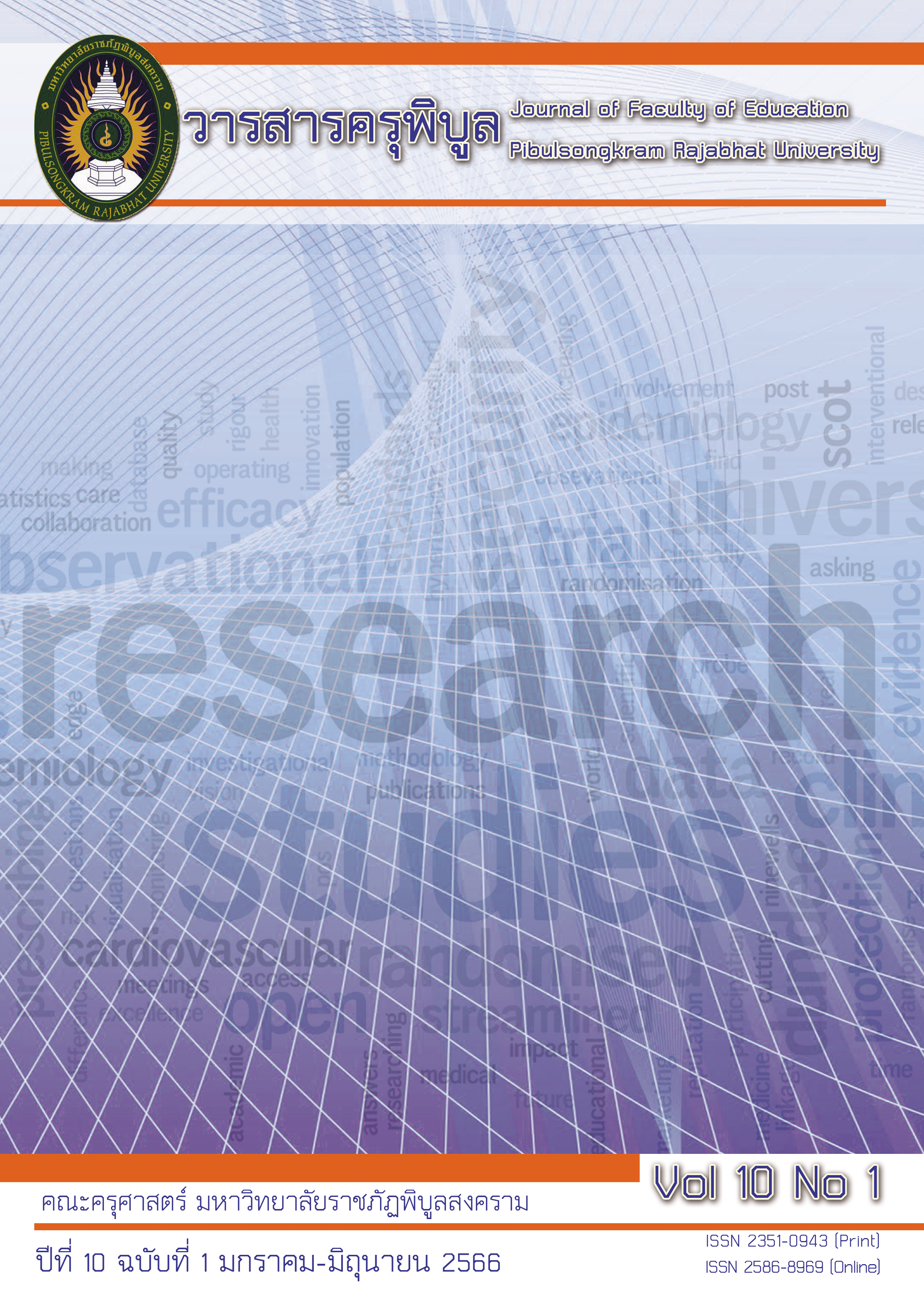A DEVELOPMENT OF A TEST ITEM BANK FOR ENVIRONMENTAL CHEMISTRY FOR TEACHERS APPLYING 4-PARAMETER ITEM RESPONSE THEORY
Keywords:
environmental chemistry for teachers, test item bank, Keywords: An environmental chemistry for teachers, item bank, 4-parameter item response TheoryAbstract
The purpose of this study was to develop a test item bank for environmental chemistry test for teachers using 4-parameter item response theory. The samples obtained by simple random sampling consisted of 200 general science students in the Faculty of Education, Roi Et Rajabhat University, in the academic year 2019. The instrument used in the research was four multiple-choice test. Data was analyzed for test parameters according to item response theory using the Program R packages including Mirt, Lavaan, Psych, and GPArotation packages before selecting the items for the bank.
The results showed that 120 test items qualified from the experts totally 90 items with the index of congruence (IOC) between 0.60-1.00. The items are listed by a parameter value and the item selection criterion to provide discriminatory power (a) between 0.50 to 5.00, item difficulty (d) between -3.00 to 3.00, pseudo-guessing (g) not over 3.00, and slipping effect (u) less than 0.70. There were 18 items which qualified a criterion for the test item bank selection. Item discrimination was between 0.55 to 4.55 with mean score at 1.96 and standard deviation at 1.38, indicating that the exam has relatively high discriminatory power. Item difficulty (d) was between –2.82 to 2.95 with mean score at 1.42 and standard deviation at 1.64 which indicated that the difficulty of the test was moderate and relatively easy.
Pseudo-guessing (g) was between 0.00 to 0.30 with their mean score at 0.06 and standard deviation at 0.01. Slipping effect (u) was between 0.72 to 1.00 with mean score at 0.93 and standard deviation at 0.00. The item bank was conducted by the PhpMyAdmin database program which could store images and texts for further development of a computerized adaptive testing program.
References
กนกกร พวงสมบัติ, สมประสงค์ เสนารัตน์ และเบญจมาภรณ์ เสนารัตน์. (2561). การพัฒนาโปรแกรม
ทดสอบและประเมินวินิจฉัยทักษะการแก้โจทย์ปัญหาเรื่อง การประยุกต์สมการเชิงเส้นตัวแปร
เดียว. วิจัยและประเมินผลอุบลราชธานี, 7(2), 90-100.
คมสัน เอี่ยมจำรัส. (2547). การสร้างและพัฒนาโปรแกรมระบบการทดสอบ. วิทยานิพนธ์ปริญญาวิทยาศาสตร์มหาบัณฑิต สาขาวิชาวิศวกรรมคอมพิวเตอร์ จุฬาลงกรณ์มหาวิทยาลัย.
จันทร์เพ็ญ มาศแสน,ญาณภัทร สีหะมงคล, ดาวรุวรรณ ถวิลการ.(2559). การสร้างแบบทดสอบพีระมิดที่ มีหลายข้อในแต่ละขั้น ที่ดำเนินการสอบด้วยคอมพิวเตอร์วิชาเคมี เรื่อง ตารางธาตุ ชั้นมัธยมศึกษาปีที่ 4.วารสารการวัดผลการศึกษา มหาวิทยาลัยมหาสารคาม. 22(1), 37-46.
ชัยวิชิต เชียรชนะ.(2552). การวิเคราะห์พหุมิติ วารสารศึกษาศาสตร์ มหาวิมยาลัยขอนแก่น, 32(4),
-22.
เบญจมาภรณ์ เสนารัตน์ และ สมประสงค์ เสนารัตน์. (2552). แผนแบบการทดลองแบบสุ่มสมบูรณ์.
วารสารการวัดผลการศึกษา มหาวิทยาลัยมหาสารคาม.15(1),25-36
เบญจมาภรณ์ เสนารัตน์, บุญชม ศรีสะอาด และจริยา ภักตราจันทร์. (2559). การพัฒนาเครื่องมือประเมิน
ความสามารถทางการวิจัยการศึกษาของนักศึกษาครูมหาวิทยาลัยราชภัฏในภาค
ตะวันออกเฉียงเหนือ.วารสารการวัดและประเมิน มหาวิทยาลัยมหาสารคาม, 22(1), 164-182
เบญจมาภรณ์ เสนารัตน์ และ สมประสงค์ เสนารัตน์. (2561). หลักการวัดและประเมินผลทางการศึกษา.
(พิมพ์ครั้งที่ 4).มหาสารคาม: อภิชาติการพิมพ์.
มหาวิทยาลัยสุโขทัยธรรมาธิราช.(2545). ประมวลสาระชุดวิชา สัมมนาการประเมินศึกษา หน่วยที่ 1-5
กรุงเทพฯ: สำนักพิมพ์มหาวิทยาลัยสุโขทัยธรรมมาธิราช.
ศิริชัย กาญจนวาสี. (2555). ทฤษฎีทดสอบแนวใหม่, พิมพ์ครั้งที่ (ฉบับปรับปรุง), กรุงเทพฯ: โรงพิมพ์แห่ง
จุฬาลงกรณ์ มหาวิทยาลัย.
ศิริชัย กาญจนวาสี. (2552). ทฤษฎีทดสอบแบบดั่งเดิม, (พิมพ์ครั้งที่ 4), กรุงเทพฯ: โรงพิมพ์แห่ง
จุฬาลงกรณ์ มหาวิทยาลัย.
สำนักงานเลขาธิการสภาการศึกษา.(2560). แผนการศึกษาแห่งชาติ พ.ศ. 2560-2579 สืบค้นเ วันที่10
มิถุนายน 2563.จาก https://www.egov.go.th/th/government-agency/242/
อรณิชชา ทศตา, ปิยะทิพย์ ประดุจพรม, และกนก พานทอง. (2562). การพัฒนาโปรแกรมคำนวณ
คะแนนจุดตัดตามแนวคิดของ Angoff โดยประยุกต์ทฤษฎีการตอบสนองข้อสอบ. วิทยาการวิจัย
และ วิทยาการปัญญา,17(2), 134-148.
Barton, M. A., & Lord, F. M. (1981). An upper asymptote for the three-parameter logistic
item-response model. Research Bulletin 81-20. Princeton, NJ: Educational Testing
Service.
Chalmers, R. P. (2020). Package ‘mirt’. Retrieved June 3, 2020, from https://cran.r-
project.org/web/packages/mirt/mirt.pdf
Choi, Y.-J. & Asilkalkan, A (2019). R Packages for Item Response Theory Analysis:
Descriptions and Features. Measurement: Interdisciplinary Research and Perspectives,
(3),168-175, Retrieved May 12, 2020, from DoI: 10.1080/15366367.2019.1586404
Dennis, C. (2006). The Essentials of Analysis. Third edition published by Continuum,
Retrieved June 3, 2020, from https://books.google.co.th/books?id=
rQ2vdJgohH0C&pg A50&lpg=PA50&dq=comrey+and+lee+1992+sample+size&source
=bl&ots=mX9lHSkT3Q&sig=ACfU3U0Y2JTPlBZOWY2O_nNEBE6oeJnkhQ&hl =th&sa
=X&ved=2ahUKEwj64e6F_uXpAhXK7XMBHQDsCKAQ6AEwEXoECAoQAQ#v
=onepage&q=comrey%20and%20lee%201992%20sample%20size&f=false.
Liao, W.-W., Ho, R.-G., Yen, Y.-C., & Cheng, H.-C. (2012). The four-parameter logistic item
response theory model is a robust method of estimating ability despite aberrant
responses. Social Behavior and Personality, 40, 1679-1694.
Loken, E. & Rulison, K. L. (2010). Estimation of a 4-parameter Item Response Theory model.
The British Journal of Mathematical and Statistical Psychology. Retrieved June, 3,
from http://dx.doi.org/10.1348/000711009X474502.
The jamovi project (2019). jamovi. (Version 1.1) [Computer Software]. Retrieved 12
June 2020, from https://www.jamovi.org
McDonald, M. E. (2002). Systematic Assessment of Learning Outcomes: Developing Multiple-
Choice Exams. Published by Jones and Bartlett Publishers
Revelle, W. (2020). Package ‘psych’. Retrieved June 3, 2020, from https://personality-
project.org/r/psych-manual.pdf
Downloads
Published
Issue
Section
License
Copyright (c) 2023 คณะครุศาสตร์ มหาวิทยาลัยราชภัฏพิบูลสงคราม

This work is licensed under a Creative Commons Attribution-NonCommercial-NoDerivatives 4.0 International License.
ลิขสิทธิ์เป็นของคณะครุศาสตร์ มหาวิทยาลัยราชภัฏพิบูลสงคราม


